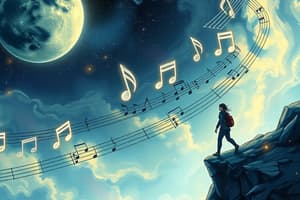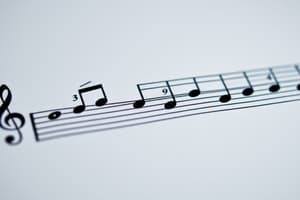Podcast
Questions and Answers
What does the term 'harmony' refer to in music?
What does the term 'harmony' refer to in music?
- Sound created by playing individual notes of a chord
- The movement of sound with accented beats
- Sound created when two or more pitches are performed simultaneously (correct)
- A linear sequence of notes
Which time signature is commonly associated with waltz music?
Which time signature is commonly associated with waltz music?
- 4/4 time signature
- 2/4 time signature
- 3/4 time signature (correct)
- 6/8 time signature
What is the basic unit of time in music called?
What is the basic unit of time in music called?
- Rhythm
- Beat (correct)
- Pulse
- Tempo
Which of the following scale types consists of five notes?
Which of the following scale types consists of five notes?
What denotes the change in pitch with a sharp sign (♯)?
What denotes the change in pitch with a sharp sign (♯)?
Which of the following represents the Major Scale Formula?
Which of the following represents the Major Scale Formula?
In terms of pitch, what does the term 'interval' refer to?
In terms of pitch, what does the term 'interval' refer to?
What does the bottom number in a time signature indicate?
What does the bottom number in a time signature indicate?
What is a triadic color scheme composed of?
What is a triadic color scheme composed of?
Which of the following colors is commonly associated with hope and freshness?
Which of the following colors is commonly associated with hope and freshness?
In the principle of design known as balance, what does 'formal balance' refer to?
In the principle of design known as balance, what does 'formal balance' refer to?
Which principle of design focuses on the diversity and contrast of elements in a work of art?
Which principle of design focuses on the diversity and contrast of elements in a work of art?
Which symbol in Asian art represents a burial marker for precious relics?
Which symbol in Asian art represents a burial marker for precious relics?
What is the primary function of calligraphy in Chinese art?
What is the primary function of calligraphy in Chinese art?
In a color wheel, what is the term for colors that are next to each other?
In a color wheel, what is the term for colors that are next to each other?
What does the principle of unity in design express?
What does the principle of unity in design express?
Which type of line is associated with action and instability?
Which type of line is associated with action and instability?
What dimension does form in art NOT have?
What dimension does form in art NOT have?
Which type of space refers to the background surrounding the subject in artwork?
Which type of space refers to the background surrounding the subject in artwork?
What refers to the surface quality of an object that can be both felt and seen?
What refers to the surface quality of an object that can be both felt and seen?
Which color is considered a warm color?
Which color is considered a warm color?
What term describes the lightness or darkness of a color?
What term describes the lightness or darkness of a color?
Which of the following is an example of an intermediate color?
Which of the following is an example of an intermediate color?
Which type of color scheme involves different shades of the same color?
Which type of color scheme involves different shades of the same color?
What is the meaning of 'Allegro' in musical tempo?
What is the meaning of 'Allegro' in musical tempo?
Which term describes the quality of sound produced by a specific instrument or voice?
Which term describes the quality of sound produced by a specific instrument or voice?
What does 'Crescendo' denote in dynamics?
What does 'Crescendo' denote in dynamics?
Which of the following is not an example of tempo?
Which of the following is not an example of tempo?
What is the chromatic scale composed of?
What is the chromatic scale composed of?
Which dynamic marking indicates a 'very soft' sound?
Which dynamic marking indicates a 'very soft' sound?
What process is referred to when music is played or written in a different key?
What process is referred to when music is played or written in a different key?
Which of these is a characteristic of the timbre described as 'guttural'?
Which of these is a characteristic of the timbre described as 'guttural'?
Flashcards
Melody
Melody
A sequence of notes heard as a single entity.
Harmony
Harmony
The simultaneous sound of two or more pitches.
Rhythm
Rhythm
The movement of sound with beats in music.
Time Signature (2/4)
Time Signature (2/4)
Signup and view all the flashcards
Time Signature (3/4)
Time Signature (3/4)
Signup and view all the flashcards
Major Scale Formula
Major Scale Formula
Signup and view all the flashcards
Interval
Interval
Signup and view all the flashcards
Accidental (Sharp)
Accidental (Sharp)
Signup and view all the flashcards
Octave
Octave
Signup and view all the flashcards
Chromatic Scale
Chromatic Scale
Signup and view all the flashcards
Tempo
Tempo
Signup and view all the flashcards
Forte
Forte
Signup and view all the flashcards
Piano
Piano
Signup and view all the flashcards
Timbre
Timbre
Signup and view all the flashcards
Transposition
Transposition
Signup and view all the flashcards
Modulation
Modulation
Signup and view all the flashcards
Analogous Colors
Analogous Colors
Signup and view all the flashcards
Triadic Colors
Triadic Colors
Signup and view all the flashcards
Color Harmony
Color Harmony
Signup and view all the flashcards
Formal Balance
Formal Balance
Signup and view all the flashcards
Informal Balance
Informal Balance
Signup and view all the flashcards
Radial Balance
Radial Balance
Signup and view all the flashcards
Batik
Batik
Signup and view all the flashcards
Calligraphy
Calligraphy
Signup and view all the flashcards
Vertical Lines
Vertical Lines
Signup and view all the flashcards
Horizontal Lines
Horizontal Lines
Signup and view all the flashcards
Diagonal Lines
Diagonal Lines
Signup and view all the flashcards
Shape
Shape
Signup and view all the flashcards
Positive Space
Positive Space
Signup and view all the flashcards
Negative Space
Negative Space
Signup and view all the flashcards
Hue
Hue
Signup and view all the flashcards
Study Notes
Elements of Music
- Melody (Tune): A linear sequence of notes perceived as a single entity by the listener.
- Harmony (Blend): The sound produced when two or more pitches are played simultaneously.
- Arpeggio: Individual notes of a chord played one by one.
- Chord: A set of three or more pitches played together.
- Rhythm (Duration): The movement of sound with accented and unaccented beats in a musical composition.
- Conducting: The art of directing a musical performance (e.g., orchestral or choral concert).
- Beat: The basic unit of time in music.
- Meter: The grouping of beats in a measure.
Time Signatures
- Top number: Indicates the number of beats in each measure.
- Bottom number: Specifies the type of note that receives one beat.
- 2/4 time signature: 2 beats per measure, quarter note gets one beat (used in march-like rhythms).
- 3/4 time signature: 3 beats per measure, quarter note gets one beat (used in waltz music).
- 4/4 time signature (common time): 4 beats per measure, quarter note gets one beat.
Pitch
- Pitch: The highness or lowness of a sound.
- 12 pitches in music: A system with letter names and solfege syllables (Do, Re, Mi, Fa, Sol, La, Ti, Do).
Scales
- Scales: Groups of notes arranged in ascending or descending order of pitch.
- Major scale: A specific arrangement of whole and half steps
- Minor scale: A specific arrangement of whole and half steps.
Intervals
- Intervals: Differences in pitch, either half steps (semitones) or whole steps (tones).
Accidentals
- Accidentals: Symbols (sharp, flat, natural) that alter the pitch of a note.
Tempo
- Tempo: The overall pace or speed of a piece of music. Different terms describe different speeds. (e.g. Grave, Largo, Lento, Adagio, Andante, Moderato, Allegro, Vivace, Presto).
Timbre
- Timbre: A unique quality of a tone produced by a given instrument or voice, differentiated by its sound color. (e.g. nasal, head voice, chest tone, guttural)
Dynamics
- Dynamics: The loudness or softness of a sound. Different terms for various levels of loudness and softness exist (e.g. forte, mezzo forte, fortissimo, piano, mezzo piano, pianissimo).
Elements of Art (Line)
- Line: An identifiable path created by a point moving in space. Can vary in width, direction, and length. Different types of lines suggest different qualities, (e.g., vertical lines = height, strength; horizontal lines = width, distance, stability; diagonal lines = action, lack of stability; zig-zag lines = excitement, fear).
Elements of Art (Shape and Form)
- Shape: Two-dimensional, usually defined by lines.
- Form: Three-dimensional objects in space.
Elements of Art (Space)
- Space: Hypothetical area where art subjects and elements operate;
- Positive space: The subject of the artwork.
- Negative space: The background or surrounding area around the subject.
Elements of Art (Texture)
- Texture: The surface quality of an object (e.g., hard, smooth, rough, soft).
Elements of Art (Value)
- Value: The lightness or darkness of a color. Tinting adds white to lighten a color, shading adds black to darken a color.
Elements of Art (Color)
- Color: Light properties. Warm or cool colors exist in the color wheel with different meanings/associations (e.g., warm colors- red/green).
- Hue: The color name.
- Intensity: Brightness or darkness of a color.
- Value: Lightness and darkness of a color.
- Color Wheel: A visual representation of colors demonstrating relationships between color schemes (primary, secondary, intermediate), and color mixing. Different color schemes exist (monochromatic, complementary, analogous, triadic).
Color Meanings
- Different colors have different associations and meanings including emotional and cultural. (e.g. green=fertility, red=passion, blue=peace).
Principles of Design
- Harmony: Produces unity by arranging consistent objects or elements.
- Rhythm: Indicates movement and tempo through repeated elements.
- Balance: Creates stability and equilibrium. Includes formal (symmetrical) and informal (asymmetrical) balance.
- Emphasis: Guides the viewer's eye to the focal point.
- Proportion: Relates elements to each other and to the whole piece.
- Variety: Introduces differences and contrasts within a composition(e.g. different shapes, sizes, colors).
- Unity: All of the elements and principles of art should contribute to the complete composition creating a whole.
Asian Art
- Batik (Indonesia): Dyes on cloth.
- Calligraphy (China): Beautiful handwriting.
- Wat (Thailand/Cambodia): Religious complexes.
- Stupa (India): Burial markers.
- Taj Mahal (India): Tomb.
- Pagoda (Buddhist): Tiered towers.
- Wayang Kulit (Indonesia): Shadow puppetry.
- Naga (Hindu/Islam): Serpent motif.
- Apsara (Hindu/Buddhist): Heavenly beings.
- Ukiyo-e (Japan): Pictures of the floating world (woodblock print and painting).
Additional Notes (Examples)
- Japanese arts: Ikebana (flower arranging), Origami (paper folding), Bunraku (puppet show), Kabuki (Classical Japanese drama).
- Noh (Japan): Japanese drama using masks.
Studying That Suits You
Use AI to generate personalized quizzes and flashcards to suit your learning preferences.
Related Documents
Description
This quiz covers fundamental concepts of music, including melody, harmony, rhythm, and conducting. It also explores time signatures and their notation, delving into how beats are organized in musical measures. Test your knowledge about these essential elements of music theory.




